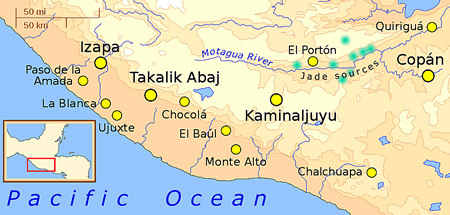 |
| Southeastern Periphery of Mesoamerica |
Southeastern Mesoamerica has been so little understood that even the two Mayan sites in the area, Copán and Quirigua, which flowered from the fifth to the ninth centuries, were thought of as the creations of itinerant Mayans rather than having been created by the Mayans indigenous to the region.
However, as Dennis Tedlock, the translator of the Popol Vuh, the holy book of the Quiché Mayans of Guatemala, has noted, the Mayan culture not only embraced Chiapas Province and the Yucatán in Mexico, but also Guatemala, El Salvador, and Honduras. According to Tedlock, “inscriptions on stone monuments [sometimes called stelae] first appeared in the ‘highlands of Chiapas’ in the first century b.c.e.”
Ultimately the inscriptions spread throughout the entire area. While it was believed that the Mayans were essentially a peaceful people, more recent excavations, like that at Bonampak, have shown them to be as warlike as those who followed them, the Toltecs and the Aztecs.
 |
Southeastern Mesoamerica, as noted in the Popol Vuh by Tedlock, became a fertile area for Mayan development. Uaxactún, in the Petén region of Guatemala, became established as a ceremonial center in the first or second centuries, and El Mirador, in northern Guatemala, was founded around the same era.
The term ceremonial center is an ambiguous one in Mesoamerican studies. Although it refers to an archaeological site that was used for religious ceremonies, certainly an urban population had to exist there permanently in order to provide the needed support for ceremonies in accordance with the Mayan calendar.
Contemporary with the Mayans, the Mixtec and Zapotec cultures flourished in the Oaxaca valleys in Mexico, while the great center at Teotihuacán dominated the Mexican highlands. City-states flourished when a particularly strong and talented ruler held sway, much as the golden age of ancient Athens is associated with Pericles.
Mayan civilization was not driven by a great need for centralization, as was later seen with the Aztecs. Instead, Mayans formed city-states like Copán and Tikal, which seemed to be locked in almost perpetual warfare with each other.
A comparison can be made to ancient Greece, with its wars among city-states like Athens and Thebes, and ancient Rome, with the centralization that would produce one of the world’s greatest empires.
With the end of the Classic period, Mayan culture gravitated away from the southeastern periphery of Mesoamerica to the Yucatán peninsula of Mexico.
Chichén Itzá, Uxmal, and Mayapán became the centers of Mayan culture in the Postclassic period, after 900. The civilization and form of government, however, remained virtually unchanged from the heyday of southeastern Mesoamerica.
Individual leaders dominated Mayan city-states. Traditional accounts of Mayan civilization have usually referred to these rulers as priest-kings, since they presided over both affairs of state and religion. However their position in Mayan society was tenuous.
During the Postclassic period, there was peace among Chichén Itzá, Uxmal, and Mayapán for about a century, until in about 1100 Mayapán went on a war of conquest and seized the other two Yucatán Mayan city-states.
For about 200 years Mayapán controlled what may have been the closest political organization to a kingdom that the Mayans evolved. Yet in 1441 Uxmal threw off the rule of Mayapán.
From then on the Mayan city-states became embroiled in a series of civil wars that would only end with the Spanish conquest that followed the arrival of Hernán Cortés in Mexico in 1519.